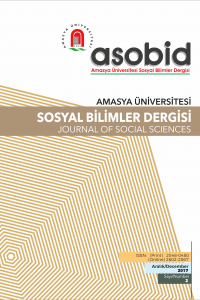Öz
Osmanlı Devleti, klasik bir imparatorluk olarak
varlığını devam ettirebilmek için nüfus hareketlerini kontrol altında tutmaya
çalışmıştır. Böylece üretimde sürekliliği sağlamayı ve vergi kaybı yaşamamayı
hedefliyordu. Ancak imparatorluğu çok zor durumda bırakan ve huzuru tehdit eden
Celali İsyanlarıyla birlikte kendini güvende hissetmeyen birçok kişi toprağını
terk ederek, şehirlere veya kendilerini güvende hissedecekleri yerlere göç
ettiler. Adem-i merkeziyetçi bir yapının hakim olduğu 18. yüzyılda ise âyanlar
ve hanedanlar idarelerindeki bölgelerde nüfus hareketlerini yönlendirdiler. Tüm
bu süreçte yaşanan göç hareketlerinden imparatorluğun diğer merkezî şehirlerinde
olduğu gibi Amasya sancağı da etkilenmiş, bu göçler sonucunda birçok aile
Amasya’ya gelip yerleşmiştir. Bu çalışmada, Temettuat kayıtlarından hareketle,
Amasya sancağına diğer Osmanlı topraklarından gelip yerleşen göçmen hanelerin
sosyal ve ekonomik durumları incelenmektedir.
Anahtar Kelimeler
Kaynakça
- Başbakanlık Osmanlı Arşivi., ML. VRD. TMT. 12911, 12974, 13024, 13027, 13034, 15981, 12898, 12900, 12902, 12904, 12905, 12906, 12914, 12917, 12921, 12924, 12927, 12928, 12932, 12933, 12935, 12937, 12939, 12940, 12945, 12946, 12947, 12951, 12957, 12959, 12964, 12968, 12970, 12971, 12973, 12978, 12979, 12989, 12999, 13009, 13023, 13025, 13030, 14706, 12920, 12934, 12962, 12998, 12942, 12953, 12956, 12960, 12990, 13033, 12895, 12897, 12899, 12918, 12919, 12969, 12991, 13001, 13004, 13005, 13032, 12824, 12877, 12913 numaralı defterler.
- Efe, Ayla (2016). 1845 Temettuat Sayım Sonuçları Ne Oldu? History Studies, C.8, s.19-35.
- Ergenç, Özer (1984). Osmanlı Şehirlerindeki “Mahallenin” İşlev ve Nitelikleri Üzerine. Osmanlı Araştırmaları IV, s. 69-78.
- Genç, Mehmet (2002). Osmanlı İmparatorluğu’nda Devlet ve Ekonomi. İstanbul: Ötüken Yayınları.
- Güran, Tevfik (1998). 19. Yüzyıl Osmanlı Tarımı Üzerine Araştırmalar. İstanbul: Eren Yayınları.
- Güran, Tevfik (2000). 19. Yüzyıl Temettuat Tahrirleri. Osmanlı Devleti’nde Bilgi ve İstatistik (Ed. Halil İnalcık-Şevket Pamuk). Ankara: Devlet İstatistik Enstitüsü Yayınları. s.73-95.
- Kütükoğlu, Mübahat S. (1995). Osmanlı Sosyal ve İktisadi Tarihi Kaynaklarından Temettuat Defterleri. Belleten, C. LIX, S. 225, s. 395-412.
- Mert, Özcan (1993). Çapanoğulları. İslam Ansiklopedisi. C. VIII. İstanbul: Türkiye Diyanet Vakfı. s. 221-224.
- Öztürk, Said (2003). Türkiye’de Temettuat Çalışmaları. Türkiye Araştırmaları Literatür Dergisi, C. 1, S. 1, s. 287-304.
Öz
The Ottoman Empire tried to control the
population movements in order to continue its existence as a classical empire.
Thus, it aimed to make sure that production be maintained without losing tax.
However, as a result of the Jalali rebellions, which left the empire in a very
difficult situation and threatened peace, many people who did not feel safe did
immigrate into the cities or places where they would feel safe, leaving their
land.
In the 18th century, when a decentralized
structure prevailed, the rulers and the dynasties ruled the population
movements in their territories. Amasya was also affected as in the other
central cities of the empire from the immigration movements that took place
during this period. As a result of these migrations, many families came to
Amasya and settled down.
In this study, the
social and economic situation of the migrant families that came to and settled
in Amasya from the other Ottoman regions are examined by drawing on the
Temettuat records.
Anahtar Kelimeler
Kaynakça
- Başbakanlık Osmanlı Arşivi., ML. VRD. TMT. 12911, 12974, 13024, 13027, 13034, 15981, 12898, 12900, 12902, 12904, 12905, 12906, 12914, 12917, 12921, 12924, 12927, 12928, 12932, 12933, 12935, 12937, 12939, 12940, 12945, 12946, 12947, 12951, 12957, 12959, 12964, 12968, 12970, 12971, 12973, 12978, 12979, 12989, 12999, 13009, 13023, 13025, 13030, 14706, 12920, 12934, 12962, 12998, 12942, 12953, 12956, 12960, 12990, 13033, 12895, 12897, 12899, 12918, 12919, 12969, 12991, 13001, 13004, 13005, 13032, 12824, 12877, 12913 numaralı defterler.
- Efe, Ayla (2016). 1845 Temettuat Sayım Sonuçları Ne Oldu? History Studies, C.8, s.19-35.
- Ergenç, Özer (1984). Osmanlı Şehirlerindeki “Mahallenin” İşlev ve Nitelikleri Üzerine. Osmanlı Araştırmaları IV, s. 69-78.
- Genç, Mehmet (2002). Osmanlı İmparatorluğu’nda Devlet ve Ekonomi. İstanbul: Ötüken Yayınları.
- Güran, Tevfik (1998). 19. Yüzyıl Osmanlı Tarımı Üzerine Araştırmalar. İstanbul: Eren Yayınları.
- Güran, Tevfik (2000). 19. Yüzyıl Temettuat Tahrirleri. Osmanlı Devleti’nde Bilgi ve İstatistik (Ed. Halil İnalcık-Şevket Pamuk). Ankara: Devlet İstatistik Enstitüsü Yayınları. s.73-95.
- Kütükoğlu, Mübahat S. (1995). Osmanlı Sosyal ve İktisadi Tarihi Kaynaklarından Temettuat Defterleri. Belleten, C. LIX, S. 225, s. 395-412.
- Mert, Özcan (1993). Çapanoğulları. İslam Ansiklopedisi. C. VIII. İstanbul: Türkiye Diyanet Vakfı. s. 221-224.
- Öztürk, Said (2003). Türkiye’de Temettuat Çalışmaları. Türkiye Araştırmaları Literatür Dergisi, C. 1, S. 1, s. 287-304.
Ayrıntılar
| Bölüm | Makaleler |
|---|---|
| Yazarlar | |
| Yayımlanma Tarihi | 14 Aralık 2017 |
| Gönderilme Tarihi | 10 Ekim 2017 |
| Yayımlandığı Sayı | Yıl 2017 Cilt: 1 Sayı: 2 |
ISSN: (online) 2602-2567


